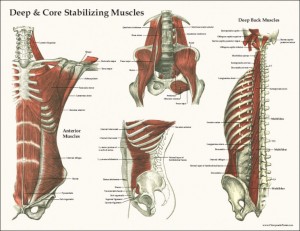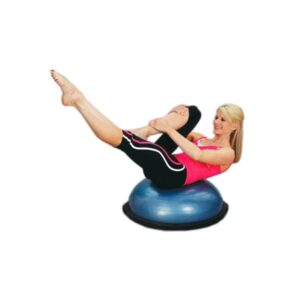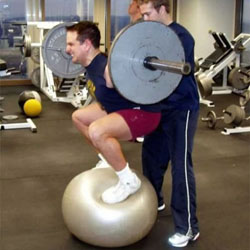Understanding what the core is, and the best exercises for a strong core
by Melissa Garcia
Did you know?
– Chronic musculoskeletal pain and chronic injuries in the spine and lower extremity are caused, or perpetuated, by muscle imbalances/weaknesses in the core musculature.
– Research indicates that 70-85% of all athletes suffer from recurrent back pain. A comprehensive core stabilization program should be done with all rehabilitation programs.
– Individuals with a weak core demonstration substitution patterns (ex: fire the wrong muscles) during dynamic functional movements leading to overuse/chronic injures both upper and lower extremities.
When you hear the word “core” what is the first thing you think of? Abs, maybe? Well, you’re not technically wrong, given all the media attention around “6-pack ab workouts” and “slim waists.” Let’s expand your definition of core beyond to include abs, and so much more!
The best core exercises may surprise you: it’s not about crunches and sit ups. To build a strong core you need to exercise a variety of muscles from your hips to your shoulders. Most people think of the core as strong, sexy abs, but the truth is that the 6-pack muscles that we see on models, called the rectus abdominus, is a very small part of the core. It has a very limited and specific action, and what experts refer to as the “core” actually consists of a series of muscles that stabilize the spine and pelvis, and run the entire length of the torso.
Fine, so it’s not just the abs – what is the Core?
 Different health professionals may give you a different definition of the muscles involved in the core. One might say it’s all about the “transverse abdominius, multifidus, pelvic floor, diaphragm.” Another might say it also includes the internal and external obliques, quadratus lumborum and spinal erectors and yet another will say “all the muscles that attach to your rib cage right down to your pubic bone” (Did you want us to list them? Well, here’s a pictures instead).
Different health professionals may give you a different definition of the muscles involved in the core. One might say it’s all about the “transverse abdominius, multifidus, pelvic floor, diaphragm.” Another might say it also includes the internal and external obliques, quadratus lumborum and spinal erectors and yet another will say “all the muscles that attach to your rib cage right down to your pubic bone” (Did you want us to list them? Well, here’s a pictures instead).
This might sound vague, but generalize the core as “the centre of the body” – the major muscles of the core reside in the area of the belly and mid and lower back, and include postural muscles that support the spine and pelvis. Peripherally, they include the hips, shoulders and neck.
How simplistic can we get to define the core? Considering the core muscles make it possible to stand upright and move on two feet…pretty simplistic. But consider what this translates to! These muscles help control movements, transfer energy, shift body weight and move in any direction. A functional core distributes the stresses of weight-bearing and protects the back. When these muscles contract, they stabilize the spine, pelvis and shoulder girdle and create a solid base of support, allowing us to generate powerful movements of the extremities (for example, hitting a golf ball farther or being able to ski double black diamonds). “Core training“ applies to everyone from elite athletes, weekend warriors, golfers, dancers, skiiers, new runners all the way to people going through car accident recovery programs, new moms, hip surgery, or someone that has weird back twinges from “who knows what.”
Having a strong core facilitates daily activities and helps prevents injuries and common issues such as back pain, which may be obvious, but did you know that many peripheral injuries from activities (take tennis as an example, and “tennis elbow”) are the result of a weak core?
In order for a core conditioning program to be effective, it needs to target muscle groups that are used for activity, strengthen those that are weak and lengthen those that have shortened – this situation occurs if there is an injury, mis- or over-use of the muscles or just from every day life (imagine what happens to your body just from sitting in a chair for hours and hours a day, every day of your life!) and be applied to the right person at the right time. While client A boasts they can do crunches forever but we discover they have can’t stabilize their body, their core training program will look very different than someone that has great proprioception, but poor core endurance.
I use the BOSU… that works core right?
 The BOSU is a great piece of equipment for working your core if used correctly for your needs. The BOSU is typically used to challenge stability, and therefore includes one component of a core-training program! And while the BOSU can help you bump up your fitness level, by adding challenge to your workout routine (by using both the flat platform side or the dome side), through the element of instability, make sure that it’s not the only type of core training that you do.
The BOSU is a great piece of equipment for working your core if used correctly for your needs. The BOSU is typically used to challenge stability, and therefore includes one component of a core-training program! And while the BOSU can help you bump up your fitness level, by adding challenge to your workout routine (by using both the flat platform side or the dome side), through the element of instability, make sure that it’s not the only type of core training that you do.
What Are the Best Core Exercises?
 Back in the 90’s when the stability ball and core craze jumped into the gym scene, many people were incorporating outrageous acrobatic stabilization “tricks” into their workouts including standing on the ball. And while this is a very impressive feat, it’s not something we’d consider a comprehensive core conditioning program and we definitely don’t recommend it. It all comes back to the question of “Whyyyyyyyy?” (If you’re a Cirque athlete and part of your show routine is doing this….now we have a purpose!)
Back in the 90’s when the stability ball and core craze jumped into the gym scene, many people were incorporating outrageous acrobatic stabilization “tricks” into their workouts including standing on the ball. And while this is a very impressive feat, it’s not something we’d consider a comprehensive core conditioning program and we definitely don’t recommend it. It all comes back to the question of “Whyyyyyyyy?” (If you’re a Cirque athlete and part of your show routine is doing this….now we have a purpose!)
Core exercises are most effective when they engage many muscles throughout the torso that cross several joints and work together to coordinate stability. Core muscles need to work as a unit, contract at the same time, across joints in order to stabilize the spine. Some of the best core exercises are simple bodyweight exercises, including the following.
PLANK
The plank works your entire core and upper- and lower-body muscles. Lie down on your stomach. Lift your body off the floor with your forearms (elbows at 90° degrees) and your toes. Keep your body in a straight position (without arching your back) and hold for 30 seconds to one minute. Lift one foot in the air for added difficulty.
V-SIT HOLD
This targets your abdominal muscles and improves your balance. Lie on your back and bend at the waist as you extend your legs and arms into the air to form a “V.” Hold this position for as long as you can.
Bicycle Crunch
This is one of the most effective crunch workouts, as it hits all of your stomach muscle fibers at once. Assume a standard crunch position, raise your torso to a 45° angle, and then twist from side to side. For an advanced movement, extend your legs and pretend to peddle a bicycle while you continue to twist.
PUSH UP PLANK
This exercise is the same as the plank, except that you are in a push up position. The push up plank works the core, chest and biceps. This is a great exercise to end your workout with; it will fully fatigue almost every muscle in your upper body.
—-
Now if you want to get a little bit fancy, here are some core exercises that involve the use of equipment.
You can challenge the basic body weight exercises listed above by adding a piece of equipment. For example once you feel comfortable doing a basic plank, you can challenge your core and your stability and perhaps do it using a BOSU or a stability ball.
BOSU MOUNTAIN CLIMBERS
Flip the ball over onto its dome. Grip the sides of the platform and come into a plank position. Run in place, quickly bringing each knee to your chest. Continue for one minute.
PENDULUM WITH BALL
Sit on a mat and place a stability ball between your legs (at your calves/ankles). Squeezing the ball in place, lie back onto the floor, and extend legs straight up into the air. Keep knees slightly bent and arms out to the sides for support. Gently tilt both legs to the right and keep your midsection tight to protect your back! Return to start and repeat to the left side to complete one rep.
WOODCHOPS
Hold a medicine ball and stand tall with your legs straight, feet hip-width apart, hips centered and abs engaged. Keeping your lower body planted, twist from the waist toward the left and extend your arms overhead and toward the left side of your head.
So there you have it – a bigger, broader picture of the core, the muscles involved being those of the torso and include postural stabilizers, as well as the reason the right core-training program needs to apply specifically to you and your goals. Now when you see magazine articles that say “work the core, have a sexy 6 pack” you can smile knowing that it’s more than a tiny (photoshopped) waist and (photoshopped) abs. It’s more than balancing on one foot while juggling dumbbells or being able to do the plank for 10 minutes straight (ouch). And even better, now you know how to spell transversus abdominius and quadratus lumborum!
Stay tuned for more information on the core, and the problem with “core” exercises.
And just for fun, you might enjoy the strength of this guy (these are pretty insane, we are not making the recommendation to do them!)
The best body weight exercises ever:







